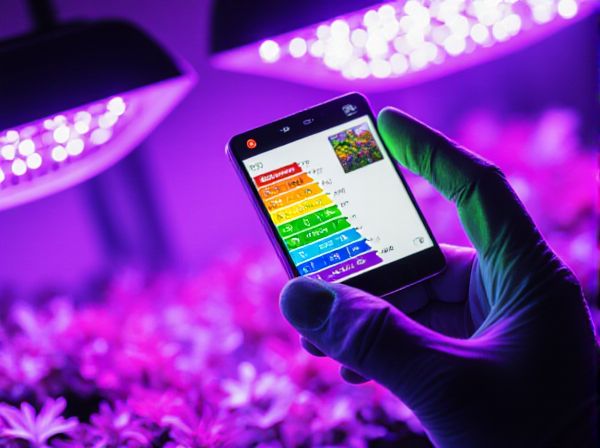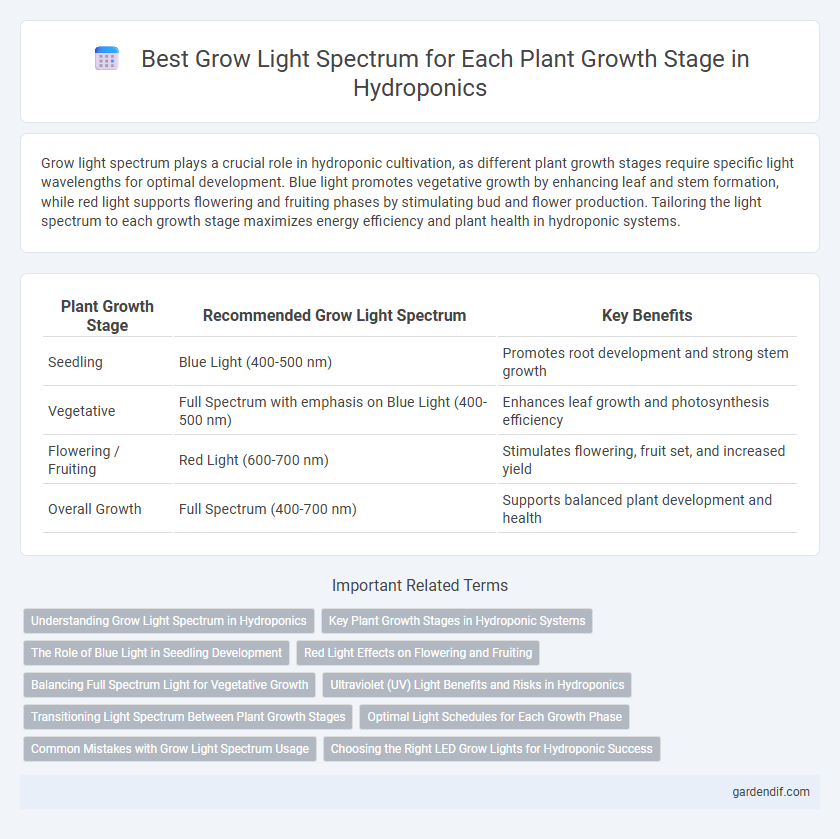
Grow Light Spectrum vs Plant Growth Stage Illustration
Grow light spectrum plays a crucial role in hydroponic cultivation, as different plant growth stages require specific light wavelengths for optimal development. Blue light promotes vegetative growth by enhancing leaf and stem formation, while red light supports flowering and fruiting phases by stimulating bud and flower production. Tailoring the light spectrum to each growth stage maximizes energy efficiency and plant health in hydroponic systems.
Table of Comparison
| Plant Growth Stage | Recommended Grow Light Spectrum | Key Benefits |
|---|---|---|
| Seedling | Blue Light (400-500 nm) | Promotes root development and strong stem growth |
| Vegetative | Full Spectrum with emphasis on Blue Light (400-500 nm) | Enhances leaf growth and photosynthesis efficiency |
| Flowering / Fruiting | Red Light (600-700 nm) | Stimulates flowering, fruit set, and increased yield |
| Overall Growth | Full Spectrum (400-700 nm) | Supports balanced plant development and health |
Understanding Grow Light Spectrum in Hydroponics
Understanding grow light spectrum in hydroponics is crucial for optimizing plant growth by providing specific wavelengths that match each growth stage's requirements. Blue light (400-500 nm) promotes vegetative growth and leaf development, while red light (600-700 nm) enhances flowering and fruiting stages. Tailoring the light spectrum to the plant's growth phase increases photosynthesis efficiency and overall crop yield in hydroponic systems.
Key Plant Growth Stages in Hydroponic Systems
In hydroponic systems, the grow light spectrum must be tailored to key plant growth stages such as germination, vegetative, and flowering. Blue light (400-500 nm) promotes strong vegetative growth and leaf development, while red light (600-700 nm) enhances flowering and fruiting. Optimizing the light spectrum for each stage maximizes photosynthesis efficiency and overall crop yield.
The Role of Blue Light in Seedling Development
Blue light plays a critical role in seedling development within hydroponic systems by regulating photomorphogenesis and stomatal opening, which enhances chlorophyll production and leaf expansion. During early growth stages, exposure to blue light wavelengths between 400-500 nm stimulates compact, healthy seedling structures and robust root systems essential for nutrient uptake. Optimizing blue light intensity and duration ensures efficient transition from germination to vegetative growth, directly impacting overall plant vigor and yield potential.
Red Light Effects on Flowering and Fruiting
Red light, particularly in the 620-750 nm wavelength range, is crucial during the flowering and fruiting stages of hydroponic plant growth as it stimulates phytochrome receptors that trigger flowering hormones. Studies indicate that increased red light exposure enhances flower bud formation, fruit set, and overall yield by promoting photosynthesis and sugar accumulation. Optimal red light ratios combined with other spectra improve fruit quality and accelerate maturation in hydroponic crops.
Balancing Full Spectrum Light for Vegetative Growth
Balancing full spectrum grow light is critical for optimizing vegetative growth in hydroponic systems, as plants require a higher ratio of blue light to stimulate leaf development and photosynthesis. Tailoring light spectrum with approximately 20-30% blue light and 70-80% red light enhances chlorophyll production and biomass accumulation during the vegetative stage. Incorporating green light improves canopy penetration, ensuring uniform growth and maximizing yield potential in controlled environments.
Ultraviolet (UV) Light Benefits and Risks in Hydroponics
Ultraviolet (UV) light in hydroponic grow light spectrums enhances plant defense mechanisms by stimulating essential oil production and strengthening plant cell walls, particularly during the vegetative and flowering stages. Controlled exposure to UV-B light increases secondary metabolites like flavonoids, improving flavor and nutritional value, yet excessive UV can cause DNA damage and inhibit photosynthesis, negatively impacting growth. Optimizing UV intensity and duration is crucial for balancing these benefits and risks, ensuring healthy, robust plant development in hydroponic systems.
Transitioning Light Spectrum Between Plant Growth Stages
Transitioning light spectrum at different plant growth stages maximizes photosynthesis and development in hydroponic systems. Adjusting blue light during vegetative stages promotes leaf growth, while increasing red light in flowering stages enhances bud production and yield. Precise spectral tuning accelerates plant maturity and improves overall crop quality under controlled environments.
Optimal Light Schedules for Each Growth Phase
Hydroponic grow light spectrum should be tailored to each plant growth stage for maximum efficiency, with blue light dominating the vegetative phase to promote leaf development and red light peaking during flowering to enhance bud formation. Optimal light schedules vary by species but generally include 18-24 hours of light during vegetative growth and 12 hours during flowering to simulate natural day-night cycles. Adjusting light intensity and spectrum dynamically improves photosynthesis rates, leading to faster growth and higher yields in hydroponic systems.
Common Mistakes with Grow Light Spectrum Usage
Incorrect grow light spectrum selection during specific plant growth stages often results in stunted development and reduced yields in hydroponic systems. Using predominantly blue light in the flowering phase or excessive red light during the vegetative stage disrupts photosynthesis and hormone regulation. Optimizing light wavelengths according to the plant's growth phase enhances chlorophyll production and biomass accumulation, preventing common mistakes like spectrum mismatch or overexposure.
Choosing the Right LED Grow Lights for Hydroponic Success
Choosing the right LED grow lights requires matching the light spectrum to specific plant growth stages, as blue light enhances vegetative growth while red light promotes flowering and fruiting in hydroponic systems. Full-spectrum LED grow lights mimic natural sunlight, supporting photosynthesis and optimizing plant development from seedling to harvest. Proper spectrum selection improves energy efficiency and yield, making it essential for hydroponic success.
Grow Light Spectrum vs Plant Growth Stage Infographic

 gardendif.com
gardendif.com